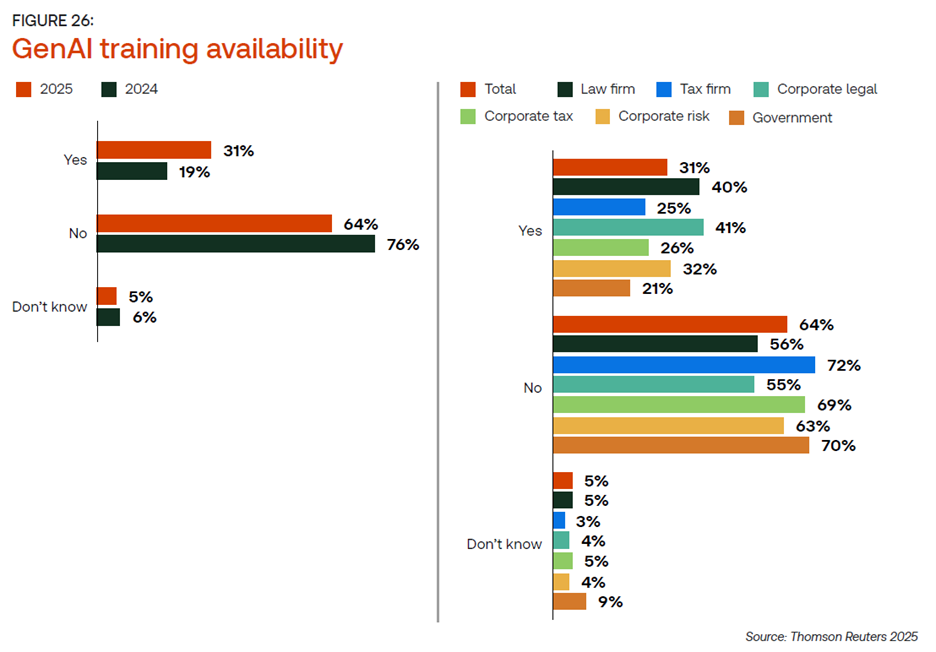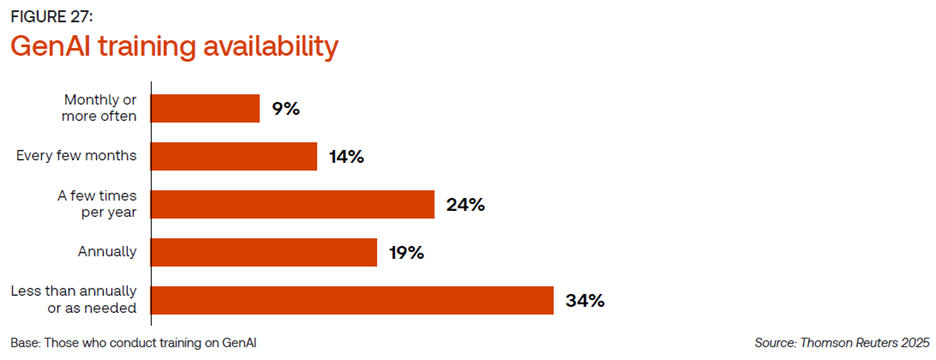Even as GenAI adoption continues to increase in professional services, a recent report reveals that training continues to lag behind. Here’s how to start — and maintain — your own long-term training program
Across all professional services industries such as legal, tax, audit & accounting, government and corporate risk & fraud, generative AI (GenAI) use is on the rise and will continue to be over the next several years. Already, 22% of respondents to 2025 Generative AI in Professional Service Report, published recently by the Thomson Reuters Institute (TRI), said their organizations have implemented GenAI within their regular workflow. An additional 50% are either actively planning or considering the technology — and 95% of all respondents said they believe GenAI will be a central part of their workflow within the next five years.
With GenAI becoming an integrated part of regular work so quickly, it’s understandable if some organizations feel like they are building the plane while flying it. In fact, only about one-third (36%) said they knew their organization had policies governing GenAI usage, and only 20% said they believe their organizations are collecting metrics around the return-on-investment (ROI) of GenAI tools. Still less than three years removed from GenAI’s public introduction, there remains work to be done surrounding how GenAI will be governed within wider business and operating practices.
There remains one major task, however, that many professional services organizations should be tackling sooner rather than later: training and education. In fact, according to the report, more professionals reported using publicly available GenAI tools like ChatGPT (41%) than have received organizational training on proper GenAI use (31%). The result means that without changes, the potential for both technical misuse and ethical misconduct with GenAI usage remains high.
The problem with less training
Early on in GenAI’s introduction to professional services, the main concern was around accuracy and hallucinations. The 2023 legal case Mata v. Avianca, in which a lawyer cited ChatGPT-generated fake cases within a court-submitted legal briefing, became shorthand for everything that can go wrong with using GenAI for professional work.
Two years later, more legal, tax, and corporate professionals are aware that hallucinations can occur and that GenAI needs to be used in concert with professionals’ expertise in order to produce accurate results. Now, however, experts believe there is a more hidden, but also costly, issue at hand within GenAI adoption — Improper use which can limit the value that GenAI tools can actually bring.
Speaking with the TRI last year, Northwestern law school professor Daniel Linna expressed fears that those slow-playing GenAI roll-out or waiting on engaging with the technology be left watching as a golden opportunity passes them by. “That’s like saying I’m not going to practice playing the game of golf, I’ll just figure out the best set of clubs to buy next year and then I’ll go out there and I’ll compete in the Tour,” Linna explained.
According to the research, many professional services organizations have not taken that advice to heart. Many have not yet begun training their professionals on GenAI tools, even as they have begun adopting GenAI throughout the enterprise.

This is an issue, because not only do 41% of professionals say they use publicly available GenAI tools such as ChatGPT, but 17% say they use industry-specific solutions that incorporate GenAI technology — and an additional 50% said they are planning to use or considering whether to use these industry-specific solutions.
Further, even if professionals are receiving training, that education may not keep up with GenAI’s rapid pace of adoption. More than half of respondents who have gotten GenAI training said that training occurs either annually or less than annually.

With this infrequency of training, professionals cannot truly keep up with new GenAI developments. After all, multiple new platforms have arisen just since ChatGPT became public in late-2022, and a host of pre-existing technologies have received GenAI-enabled upgrades. For many professional service organizations, it is clearly not enough to check the box of AI training. Given the rapid pace of technological change, any GenAI training needs to be a longitudinal program.
4 tips on training
GenAI technology is not simply something that professional services organizations can adopt and forever assume it will function correctly. In order to get the most out of GenAI tools, it takes an integrated plan of people, processes, and technology to extract the most value from these ever-changing tools.
Here are a few tips that can help those organizations that are looking to start — and continue to iterate — their own GenAI program.
-
-
- Find the value above and beyond — GenAI technology’s use cases are very widespread, with everything from research, discovery and contracts in law, to generating returns in tax, and more. Because of this, it can be easy to become focused solely on how the technology functions and ignore the why. However, by connecting GenAI use cases to the bottom line — how it’s helping save money, gain efficiencies, or aid client service — GenAI trainers can more easily gain buy-in from users.
- Have power-users teach peers — Particularly with professionals such as lawyers, accountants, and others, technology newcomers love hearing from their peers. Establishing a training team that not only includes IT and HR staff, but also professionals’ own peers, can help create GenAI use case stories that truly hit home. “The best people to tell them what’s in it for me, is that other lawyer,” recently explained Don Sternfeld, Chief Innovation Officer at law firm Steptoe. “They won’t listen to my emails, but they’ll listen to their peers in that meeting who says, ‘Oh, this is something out there.’”
- Measure, measure, measure — Only 20% of all professionals said they know that their organizations are collecting data around GenAI’s ROI, according to the report, which from a business perspective raises issue of how best to serve clients. Yet, it also can cause issues internally around making sure AI-driven tools are used to the best of professionals’ ability. Even simple metrics such as employee usage rates and employee satisfaction can help guide how and in what areas GenAI can be best utilized, while business metrics such as client satisfaction and projected external revenue generation can help make the business case for continued investment in training on tools.
- Keep up with changes — GenAI technology changes rapidly. After all, the public version of ChatGPT, otherwise known as GPT-3.5, was released in November 2022, and already GPT-5.0 is expected to be released in Summer 2025. As a result, some skills such as prompting and hallucination-detection may decrease in importance as GenAI tools become more accurate, while other skills such as ensuring ethical use and proper data governance may increase in importance as GenAI becomes more pervasive. Constant training allows professionals to keep up with these changes and adapt their own usage trends to match their organizations’ changing technology stack.
-
You can download a full copy of the 2025 Generative AI in Professional Services Report here







